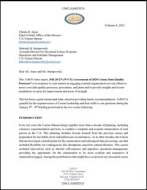Assessment of 2020 Census Data Quality Processes
Assessment of 2020 Census Data Quality Processes
Introduction
Every ten years the Census Bureau brings together more than a decade of planning, including extensive experimentation and tests, to conduct a complete and accurate enumeration of each person in the U.S. This planning includes lessons learned from the previous census and preparation for inevitable errors and unforeseen circumstances. As in other decades, the Census Bureau developed a detailed plan for the enumeration and subsequent data processing, one that included flexibility for contingencies like disruptions caused by natural disasters. This census included innovations such as internet self-response and paperless operations-management, providing the opportunity for the enumeration to be more resilient and responsive if enumeration lagged. Among the perturbations that might have occurred in any decennial census were tropical storms, wildfires, and civil unrest. The twelve years of planning for the census could have surmounted these problems in the normal course of business. However, the unprecedented disruptions associated with the COVID-19 pandemic raise special concerns over the possible erosion of data quality of the 2020 Census. The COVID-19 pandemic caused an almost complete, albeit temporary, shutdown of field operations. In response, the Census Bureau at first planned to delay the normal schedule by four months but was subsequently required to replan and compress the schedule. These issues gave rise to the Census Bureau’s engagement with JASON to help assess their data quality processes and procedures, and to elicit recommendations on areas for improved communication. JASON was asked to comment upon actions Census Bureau might take to strengthen the production and release of metrics to evaluate 2020 Census data quality. The focus of this report is the data quality of this census, compared with what would have been achieved in better circumstances, with a specific focus on the fitness of the data for the constitutional and statutory uses of the census.
Several other events compounded the complications associated with COVID-19 that, although not the focus of this letter, are worthy of mention. Controversy around counting non-citizens added unscheduled tasks, including conducting a 2019 Census Test to evaluate how a citizenship question would impact response rates. The U.S. also experienced twelve landfalls by named storms and prodigious wildfires in the Western United States. These environmental disruptions caused displacement of individuals, hampered in-person enumeration interviews, and may have altered response rates.
The Census Bureau asked JASON to
- provide recommendations, suggestions, and insights supporting 2020 Census efforts to ensure and provide quality data and metrics;
- identify strengths in the Census Bureau plans for data quality assessments and metrics;
- identify weaknesses and opportunities to strengthen Census Bureau plans for data quality assessments and metrics; and to
- provide recommendations on communicating important aspects of data quality that could accompany release of 2020 Census data products.
During January 4th through the 8th of 2021 JASON was briefed on census operations in the field, and the post-data collection processing that is currently underway for the delivery of resident population counts to support Congressional Apportionment and Redistricting Data Products. Our comments are informed by those discussions along with an extensive set of internal documents provided to understand the operational details of data collection and subsequent processing.




